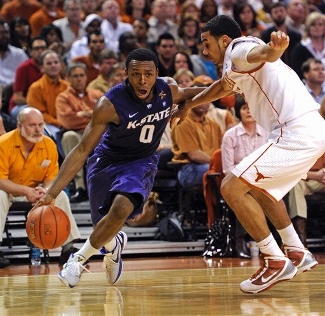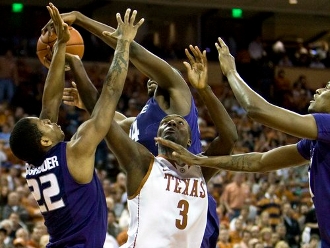If Rick Barnes and the Longhorns could have their way, the month of February would disappear from the calendar. In 2008, the Longhorns went on a perfect 8-0 march through the month of February, and then cruised all the way to the Elite Eight of the NCAA tournament. Since then, Texas has posted a 13-11 mark during the last three Februaries and has failed to make it out of the second round of the Big Dance. Last night, the Longhorns continued their February blues, as they closed out their home schedule with a disappointing loss to Kansas State, the team’s third defeat in its last four games.
Jacob Pullen scored 16 second-half points Kansas State stifled Texas with stout interior defense, while the Longhorns went completely cold from long range. On the offensive end, the Wildcats rode a strong second-half performance from Jacob Pullen and the hot shooting of Rodney McGruder to win their seventh game in the last eight. What looked good The Longhorns attacked the strong K-State frontcourt early and often. Tristan Thompson played nothing like a freshman, scoring 18 first-half points to carry Texas through the first half. The big man even made four out of his five free throw attempts, a shocking number considering his season average was just south of 48% coming into the game. The Longhorns also benefited from strong rebounding in the first twenty minutes, reclaiming 48% of their misses. With the team shooting so poorly, the offensive rebounds helped to mask the inefficiency and allowed Texas to earn second-chance points that kept them ahead for nearly the entire first half. The early defense from Dogus Balbay and Cory Joseph on All-American Jacob Pullen also helped Texas maintain their narrow lead. While big man Curtis Kelly was hitting fadeaway jumpers like they were layups, Pullen was practically a non-factor. Balbay and Joseph fought through screens and stayed right in his shirt, limiting him to a 2-of-7 start from the field. What needed work Unfortunately, the game was once again a tale of two halves. While the first half was far from great for the Longhorns, the second one was a complete disaster. Texas opened the second stanza with a scoring drought of nearly five minutes, letting the Wildcats claim the lead and build it as large as six points before Jordan Hamilton finally made a bucket with his foot on the three-point line. That basket was only Hamilton’s second of the entire game, and it came after he had already missed ten shots and turned it over three times. His offensive attack consisted of trying to shake his man off the dribble, but the Wildcats were prepared every time. When Hamilton attacked from the wings, he was met with extra defensive resistance, but never knew what he was doing with the ball. It would be nice to give him credit for not forcing up a shot every time, but in the rare cases he did try to make a pass, he waited until he was already in midair or tried to throw it through the legs of about 18 different people.
Jordan Hamilton couldn’t get it going against KSU In the last five games, Hamilton is just 26-of-85 from the floor (30.6%). In the three losses to Nebraska, Colorado, and Kansas State, the sophomore is just 9-of-28 from behind the arc (32.1%), a far cry from the 41.5% mark he posted in Texas’ first ten conference wins. The key difference is that Hamilton’s three-point attempts now mostly come off of the dribble, oftentimes with a defender nearby. When the Texas offense was clicking through the month of January, Hamilton was coming off of curls for lightning-quick catch-and-shoot plays, which he was knocking down with regularity. Now, Hamilton is having to create his looks with his hands instead of his feet, and it’s killing the Longhorn offense. The rest of the Longhorns were just as cold from the field. While Thompson was carrying the team, the rest of the Texas lineup combined to shoot just 25.9% from the field. The Longhorns made just three of their first 14 three-pointers, before J’Covan Brown drilled a pair in the final minute to make things interesting. The 27.8% mark behind the arc was the worst for Texas since going 2-of-8 in a blowout win over A&M at Reed Arena. Defensively, the second half was an embarrassment. For a team that was posting historic defensive efficiency numbers just three weeks ago, the abundance of complete breakdowns in the half-court set was completely unacceptable. The Wildcats were able to get to the rack with no problem in the second half, scoring 14 points in the paint during the final 20 minutes. Meanwhile, Rodney McGruder, a 42% career three-point shooter, constantly found himself wide open in the corner on kickouts. While the Longhorns were selling out to stop the drive, they seemingly forgot how to close out on shooters, and McGruder drilled four key three-pointers to make them pay. Just as with Colorado’s Levi Knutson on Saturday, Texas completely ignored the scouting report and consistently lost the best pure shooter on the floor. A final point to illustrate the defensive collapse of the Longhorns is the sudden ballooning of their opponents’ effective field goal percentage. Fellow tempo-free stat nerds will already be familiar with the concept, but allow me a brief explanation. Essentially, eFG is an alteration of the classic field goal percentage that gives extra weight to the three point shot. Since a three is worth 1.5 times the points of a regular shot, it is worth that much in the calculation of the shooting percentage. During Texas’ 11-game winning streak to open conference play, the Longhorns held opponents to an eFG of just 39.2%. In their three losses to Nebraska, Colorado, and Kansas State, the Longhorns have allowed an eFG of 55.5%. Texas is not just losing games. The team is having an outright defensive collapse. Next up: at Baylor (18-10 overall, 7-7 Big 12); Saturday, 8 P.M. |
One Response to “Texas continues its slide in loss to K-State”











on 01 Mar 2011 at 12:26 pm # Grant
Difficult game to watch, especially in the second half when it was pretty clear from the start that they were going to be better than us on both ends of the floor. Our guys made some bewildering mistakes, like Dogus’ charge on the fastbreak, Jordan leaving McGruder wide open in the corner off the inbound. Jordan’s d and inability to close on the shooter really hurt us. Hate to sound like another Barnes hater, but where are the screens and picks to get our shooters open looks? Offensively we looked stagnant and often times flat-out inept. Lots of standing around. Not sure what’s happened to our defense. Granted K-State is one of the hottest teams in the country, but you have to wonder where our killer instinct has gone after pissing away the conference to KU once again.